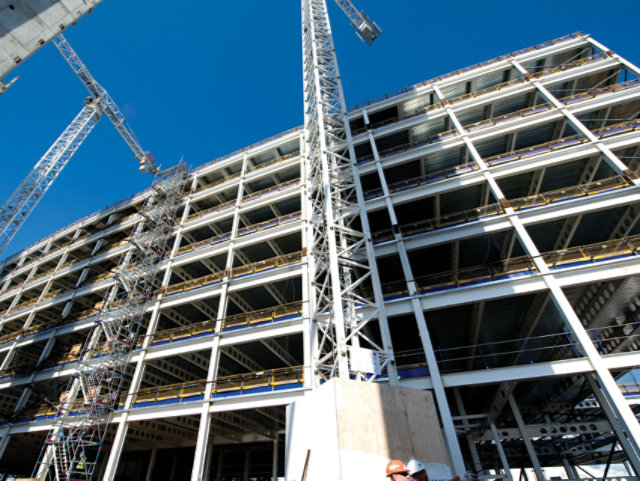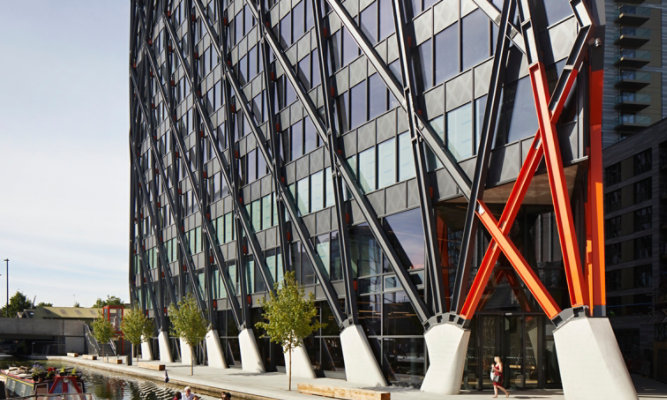
No Compromise for Modern Structures
The use of steel in modern building design offers even more flexible usage than ever before, and with it comes the need to ensure that fire safety is not compromised along the way.
By Bob Glendenning, Global Fire Engineering Manager
Modern buildings
Architects and design engineers can use cellular beams for example to great effect, sometimes left exposed as part of the aesthetic finish, and adding to the fascination of tall, complex structures.
As the design is pushed to the boundaries using steel in all its forms, so the load-bearing equations can alter and as other considerations come to the fore the need for the appropriate level of fire safety becomes paramount.
Although fire deaths are falling, insurers are concerned at increasing fire losses, which are at the highest level ever experienced since records began, totalling around £3.4 million per day.
The use of new materials and modern methods of construction are also resulting in greater volatility to fire.
However, there is an increasing blurring of the lines of precisely where the responsibility for fire safety lies through the process of concept, design and installation.
It can change project by project but should in practice lie with the designer along with other specification details, whether they are amended through the development stages or not.
The reality is becoming slightly different, and worrying. Quite often the steelwork contractor or specialist site fire protection contractor is now expected to take on this responsibility as the project build moves through the process.
They in turn will often rely on other suppliers in the chain for advice such as coatings experts. We at Sherwin-Williams often provide guidance on products to all known standards and are happy to do so as part of our own part in the supply chain.
Ultimately, the responsibility under legislation lies with the ‘Responsible Person’ as described in the Fire Safety Reform Order (2005), which for the purposes of the law is referred to as ‘the employer and/or the building owners or occupiers.’
Risk assessment
They are duty-bound to carry out a fire safety risk assessment and keep it up to date. This shares the same approach as health and safety risk assessments and can be carried out either as part of an overall risk assessment or as a separate exercise.
Based on the findings of the assessment, employers need to ensure that adequate and appropriate fire safety measures are in place to minimise the risk of injury or loss of life in the event of a fire.
Once they have identified the risks, they can take appropriate action to control them, remove the risk altogether or reduce the risk and manage them. They should also consider how they will protect people if there is a fire.
How is the Responsible Person to understand and act to cover these issues? The only way very often is to employ fire safety experts, which in turn comes with a cost. A worrying trend is emerging where the complexity of fire safe design means it can be out of the sphere of knowledge of the Responsible Person, the steel frame designers and indeed, where employed, the fire consultant, particularly if employed to consider non-structural aspects of fire safety.
Designing structures in the ambient state with no consideration for the fire condition is unacceptably risky and irresponsible. Our current industry procedures mean that this can easily happen and the burden of ensuring fire safe design, which may well include additional costly measures, is placed with either the wrong party or, in the worse case, missed altogether.
The danger in cutting corners is that the fire safety measures will be compromised. We believe the responsibility in modern building design should lie with the designer up to handover of the building and then, with full knowledge of all fire safety requirements, it becomes the responsibility of the owner/manager.
We believe there is a need for clarity here as building design develops against legislation scoped out some years ago to different design models/codes, particularly in relation to beams with web openings.
The level of protection afforded on any building where large numbers of people move about has to be proportionate to the structure. If this falls short, the time the protection provides for rescue services in the event of a real fire could be reduced and potentially the load bearing capacity of the steel breached much more quickly than anticipated, threatening the safe evacuation of people.
At Sherwin-Williams, we have developed our own piece of software to make sure these calculations can be specific and measurable.
For the first time, the software in the new Firetex Design Estimator 2.0 (FDE) offers the capability of providing calculations for all shapes and configurations of apertures within cellular beams as well as efficient handling of unfilled voids with trapezoidal profiled metal decking systems.
Project sharing
Other benefits of this package include project sharing as well as designs to the emerging Eurocodes. The FDE is independently tested and fully verified under the Exova Certifire scheme and, in the case of cellular and fire engineered beams, further verified by the University of Manchester. Of real interest to the contracting world is that the FDE is also fully Building Information Modelling (BIM) enabled. Working closely with our partners we enable our FIRETEX fire protection properties to be fully visualised in the 3D model and available for all stakeholders including QA for application (construction as well as tender bidding) as well as the fire and rescue services and building owners during service.
The estimation and design tool also provides support where a limiting temperature has been specified, useful when a client is working alongside a fire safety consultant for example.
The benefits of best practice in fire safety engineering can be seen as an integrated package of measures within the FDE, designed to achieve the maximum benefit from the available methods of preventing, controlling or limiting the consequences of fire.
Some of those in the supply chain may question why steel parts for new buildings - whether a beam, column or brace for example - would be overly-specified and under-utilised in terms of their load bearing capacity in their ambient design state.
In reality, this performance-based approach allows designers to account for different applied loads being used in various parts of a building for a diverse set of reasons rather than the ‘one-size-fits-all’ prescriptive approach which assumes loads and tolerance.
The trend to assume loads well under the reality of performance-based modelling on each section of steel in today’s complex buildings - thus creating savings for the project in fire protection - is dangerous indeed.
This issue is becoming more complex as designers factor in longer span beams as the pressure to create more letting space becomes more intense.
With more openings and fewer columns, the flexibility of buildings also increases to meet the needs of usage today, with many new steel structures accommodating commercial use as well as living, retail and leisure within the same structure.
Increased knowledge of how real buildings react in fire and of how real fires behave, has led many authorities to acknowledge that improvements in fire safety may now be possible in many instances.
Using modern fire protection design, savings can be made when used professionally and can play a major part in delivering a safe, cost-effective project.
It is the responsibility of the designer working with the fire protection expert to establish the correct level of steel ambient utilisation and with it the appropriate level of protection, amended if needed through the development.
At the heart of fire engineering is safety, no matter how complex and demanding the buildings, in the interests of lives and property.
Discover More
Industry Expertise and Innovation
See how we help customers find customised solutions for their project and application challenges.
Technical Service
We're here to ensure your entire project is running smoothly and efficiently.
LEARN MOREProduct Lookup
Find out more about our innovative coatings for a variety of industries.
FIND A PRODUCT

